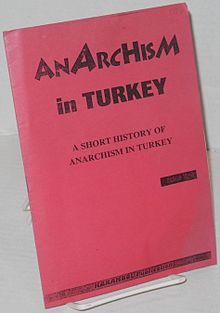Anarchism in Turkey
This article includes a list of general references, but it remains largely unverified because it lacks sufficient corresponding inline citations. (November 2019) |

| Part of a series on |
| Anarchism |
|---|
 |
|
Anarchism in Turkey only began to emerge in 1986 with publication of the magazine Kara.[1]
Marxism was the most influential ideology in the Turkish revolutionary movements, until its disintegration due to the military coup d'etat of Kenan Evren in the 1980s. Almost the entire Marxist movement was crushed by military repression. Many militants faced the dilemma of advocating for the ultimate goal of Marxism in reaching a society without a State and without social classes, and the real politics of statism and authoritarianism that Marxist parties actually practiced. From this debate, a trend emerged that embraced the anarchist ideology, differing from the rest of the Turkish left wing, which maintained the traditional Leninist position.
Historical background[]
Ottoman Period[]
The first signs of anarchism in the Ottoman period emerged around Armenian intellectuals. magazine, published in 1895 by , one of the pioneers of the Armenian Revolutionary Federation, has a rich content regarding both anarchist philosophy and the Armenian revolutionary movement. In the same period, Turkish Cypriot 's French work Socialisme et Anarchisme (1895) became the first anarchist book published in the Ottoman Empire.[2]
, who is often regarded as the first Turkish anarchist, states in his Felsefe-i Ferd (1913) that from wage slavery to socialism and from socialism to anarchism, a new age will be achieved.[3]
Republican Period[]
The first written source of Turkish anarchism is Kropotkin's Ethics, translated by Ahmet Ağaoğlu and published in 1935.[3] Although there is an ongoing debate on why anarchism has not gained visibility as an alternative leftist policy in the first half of the Republican period,[4][3][5] until the 1980s, anarchism was widely seen as equivalent to terror and chaos.[citation needed]
In the 1970s, while Marxist and socialist approaches dominated the leftist perspective, interest in anarchism remained pale in left-wing publishing. While articles on anarchism were featured in the magazine published in the 1960s, Proudhon's book What Is Property? was translated into Turkish and published.[3]
After the 1980 Turkish coup d'état, anarchism began to take its place in Turkey's political scene. In particular, anarchism gained a lot of traction in the Turkish diaspora in Germany, where many people had fled from the coup.[3]
Launched in 1986, magazine was taken as a turning point in terms of the anarchist movement in Turkey. Kara was published at a time when the mainstream Turkish left could not overcome the shock of the military coup, defined itself as "libertarian" instead of "anarchist", due to the general perception of anarchy as chaos. In addition to broader social movements, anarchist groups and publications formed in the early 1990s, including ones following platformist, anarcho-syndicalist and synthesist traditions.[3]
In 1998, the (AGF) was established, followed by the (AKI) and (DAF) in the early 2000s.
By the 2000s, the word anarchy was no longer synonymous with chaos and terror, and began to be seen as a political philosophy. Today, anti-authoritarian and horizontalist tendencies in many Turkish political organizations can be observed sprinkled with heritage from the anarchism of the 80s, including in the Kurdish and women's liberation movements.[citation needed] Anarchists were involved in the Gezi Park protests of 2013.
See also[]
- Politics of Rojava
References[]
- ^ https://www.okuryazar.tv/baris-soydan-turkiyede-anarsizm-yuz-yillik-gecikme/
- ^ "Osmanlı'da Anarşizm – Sarayın Kapısına Dayanan Anarşistler: İtalyan İşçi Birliği". Meydan Gazetesi’nin (23). 24 December 2014. Retrieved 25 March 2021.
- ^ Jump up to: a b c d e f Özkaya, Emine; Zileli, Gün (2007). "Anarchism in Turkey". In Mehmet Ö Alkan; Murat Belge; Ahmet İnsel (eds.). Modern Türkiye'de Siyasi Düşünce (in Turkish). VIII: Sol. Istanbul: İletişim. pp. 1153–1168. ISBN 978-975-05-0507-2. OCLC 634870795.
- ^ Soydan, Barış (2013). Türkiye'de Anarşizm: Yüzyıllık Gecikme (in Turkish). İstanbul: İletişim. ISBN 9789750511301. OCLC 855212782.
- ^ Saltoğlu, Rıfat (2014). "Türkiye'de 'anarşist aydın' olmak". Mesele (in Turkish). Archived from the original on 22 August 2017.
Further reading[]
- Corlu, Axel (2016). "Anarchists and Anarchism in the Ottoman Empire, 1850–1917". In Karahasanoğlu, Selim; Demir, Deniz Cenk (eds.). History from Below: A Tribute in Memory of Donald Quataert. Istanbul: Istanbul Bilgi University Press. pp. 553–583. ISBN 978-605-399-449-7. OCLC 961415226.
- Evren, Süreyyya (19 November 2006). "Kara bayrağın Türkiye'de yirmi yılı". BirGün Köşeyazıları. Archived from the original on 22 August 2017. Retrieved 20 May 2018.
- Soydan, Barış (2013). Türkiye'de anarşizm: yüz yıllık gecikme [Anarchism in Turkey: One Hundred Years of Delay]. İletişim yayınları Bugünün kitapları (in Turkish). Istanbul: İletişim. ISBN 978-975-05-1130-1. OCLC 855212782.
- Zileli, Gün; Özkaya, Emine (2007). "Türkiye'de Anarşizm" [Anarchism in Turkey]. In Gültekingil, Murat; Bora, Tanıl (eds.). Modern Türkiye'de Siyasi Düşünce (in Turkish). 8: Sol. Istanbul: İletişim. pp. 1153–1168. ISBN 978-975-05-0507-2. Archived from the original on 20 May 2018.
- Anarchism in Turkey
- Anarchism by country
- Politics of Turkey